Posts Tagged: U-Pick
Twenty minutes of hail

Hail comes sometimes, suddenly and randomly, in February or March or April. It can hit one farm but not the one down the road. This time the sudden hail hit Woodland farmers Robert and Debbie Ramming, owners of 40-acre Pacific Star Gardens, on March 31, almost as if Mother Nature couldn't wait for April Fool's day.
Mid-April, in most years, is a good time to visit strawberry farms in the Sacramento Valley for the earliest fresh juicy berries, but 20 minutes of hail put off the start of U-pick strawberry season at Pacific Star Gardens until May. The plants will survive, but damage to the berries and other crops will mean a loss of $5,000 to $10,000 for the Rammings - a big hit for a small-scale farm.
The hail was huge, pea size to marble size, and it came in at a 45 degree angle, hurting Robert's head through his cap. It destroyed the field of strawberries just starting to turn pink and the newly planted cantaloupes and other melons that would have ripened in early July.

Pacific Star Gardens will recover. The next bloom of strawberries will be ripe and ready for U-pick in early May, with apricots and blackberries soon after. The farm is between Davis and Woodland, just off Highway 113. Check the Facebook page for what's ripe and when the farm is open for picking or purchase at the farm stand.
This is a farm story. This is a story of your food. It might make you think a little differently about strawberries, or about hail, or about the farmers at your farmers' market. Most farmers have stories to tell, and most would like the rest of us to understand a little bit about what it takes to grow crops and raise animals. We are lucky to have many opportunities to learn about and experience California farms and ranches.

UC is also partnering with the California Department of Food and Agriculture (CDFA) to help Californians explore California farms through a new page on the CDFA website, Discover California Farms. This one-stop portal to agricultural adventure helps visitors find a farm or ranch to visit, locate their closest farmers' market, find a community supported agriculture (CSA) farm that delivers weekly boxes of produce, learn about farm trails, fairs and festivals, or watch videos telling farmers' stories. California farmers and ranchers invite you to visit,taste, learn and enjoy!

U-Pick strawberry sign
The promise of peaches
Tomatoes grow fine in my Sacramento backyard. I can usually count on plenty of basil, more zucchini than the neighbors will take, some snow peas, chard and kale, a few small peppers and eggplants and whatever salad greens survive the slugs (in other words, lots of arugula). We have oranges and grapefruit, but I wouldn't even try to grow peaches or apricots. It takes a farmer to grow peaches. It takes a good farmer to grow good peaches. It takes a good farmer and good weather to grow Blenheim apricots.
Instead of planting a peach tree, I joined a fruit community supported agriculture (CSA) program, promising to pay $15 a week for a box of fresh fruit every week from June 7 until October 4. By joining I am agreeing to share the risk and the promise of the harvest of a four-acre fruit orchard with four part-time beginning farmers growing fruits and vegetables just west of Davis.
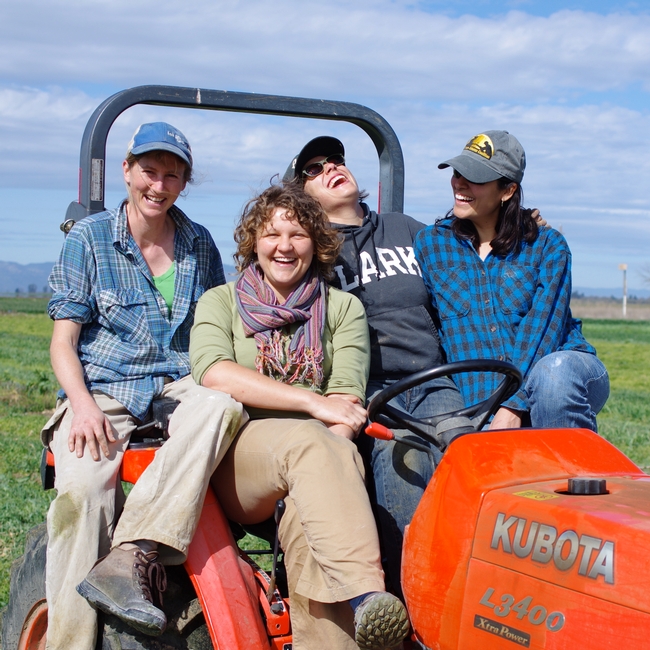
The Cloverleaf at Bridgeway Farms offers a chance that is, Aubrey White says, "both attractive and terrifying, with everyone trying to make it happen while keeping their jobs." The monetary investments were low, as they have no buildings or heavy equipment, and Collins offered a very attractive lease arrangement to encourage the new farmers. The vegetable land is certified organic and the orchard land is in transition to organic. The part that is terrifying is the risk of crop failure and poor yields that all farmers face.
The Cloverleaf farmers all have some farming experience, but the orchard presented new challenges. White started with the UC Master Gardener Program in Los Angeles, worked with urban farms and community gardens, and for two years at the UC Davis Student Farm. But, she says, taking on the orchard involved a "crazy different learning curve for three out of four of us." Even with all of her agricultural experience, she felt at a disadvantage not having a science background, particularly not having the soil science information to best manage the orchard.
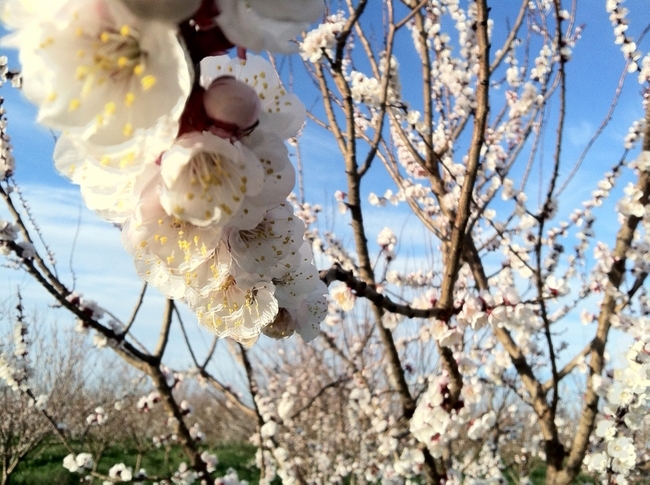
The original point of CSA programs was for the community (eaters) to share the risk of farming with the farmers, and to pay for a season's worth of produce up front to ease the cash-flow burden on the farmer before the harvest. In a pure traditional CSA, the farmer estimates the production for the year and sells shares in that production to as many families as the farm can be expected to feed. Each family receives a box of produce every week, with the full week's harvest divided up among the boxes. Some weeks there would be more variety than others; bounty and low yield would all be shared. Some years there would be good harvests and some years, poor harvests. The farmers are not at the mercy of the market, either wholesale buyers or competitive farmers' markets.
Most California CSA operators do not follow this traditional model, but sell to wholesale customers, restaurants, farmers markets and food processors in addition to the CSA customers. This means, in practice, that CSA customers do not share the full risk of the farm production and can expect a more consistent quantity in their box or basket each week. However, CSAs are an important and valuable part of most CSA operators' marketing plan. A UC study of several California organic farms selling through different marketing channels showed that the CSAs consistently returned the most profit to the marketing investment.
As a small farm with a young orchard, The Cloverleaf's fruit CSA still involves a little risk to the members. If the rain continues through June, as it did last year, we may not get those delicious Blenheims. Last year everyone lost them. But CSA manager White promises to give first priority to the CSA customers, with 25 to 50 percent of the fruit harvest going to CSA members. If needed, Cloverleaf will buy more blackberries from Collins or fill the boxes with the more successful varieties of peaches and nectarines.
In addition to the CSA, The Cloverleaf farmers will operate a farm stand, several U-pick days and a harvest festival this year, and sell fruit to several wholesale buyers. Just in case they don't have enough to do, they are considering introducing pastured chickens to the farm next year. The farm stand will open on Memorial Day at the Kidwell Road exit off Highway 80 between Davis and Dixon, and will remain open on Saturdays and Sundays until October. Information about the U-pick days and the harvest festival (and lots of other on-farm activities throughout California) will be listed on the UC Agritourism Directory, www.calagtour.org.
There might be a few shares left for the fruit CSA. For more information, visit the website or Facebook page of The Cloverleaf at Bridgeway Farms or email thecloverleaffarm@gmail.com. I'm looking forward to those peaches!
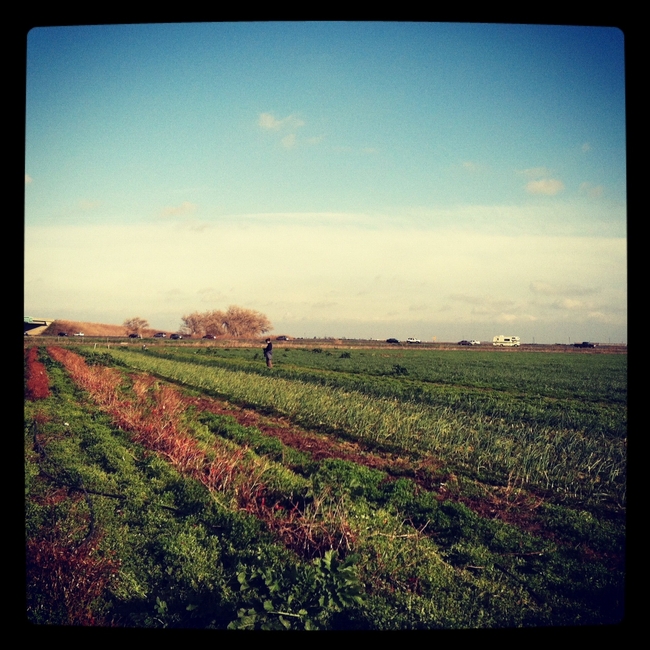
Fresh picked in the Delta

By 11 o'clock in the morning, Susila Prasab and her family had already picked about a hundred pounds of fresh crowder peas. They climbed off the tractor-pulled wagon that brought them back from the picking field with about five big mesh bags full, ready to get them weighed and pay the Kelley Farm 78 cents a pound. The fresh beans (crowder peas, like black eye peas, are really beans) would soon be shelled, cleaned, blanched and frozen, ready to use as the main ingredient for several months' Indian curry meals. Prasab told me the quick version of her curry recipe.
Quick Indian curry: Like many recipes, it starts with onion, garlic and chili sautéed in a pan with a little oil. Add curry powder and marsala. Wash the shelled fresh beans and add them to the pot. You can add potato or eggplant or tomato or cilantro, or all of them if you want. Add a little water, cook slowly, and serve with rice.
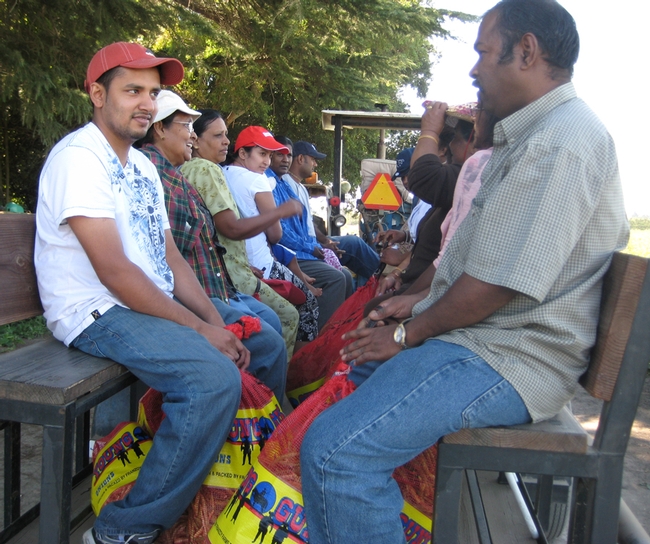
Nath Sam, from Fiji by way of Elk Grove, stopped picking purple beans for a few minutes to explain the best way to keep the beans for three seasons in the freezer:
Prepping fresh beans for the freezer: Shell the beans. Boil a lot of water. Throw the beans in for just a few seconds. Take them out quickly and cool them with ice. When they are room temperature, put them in a ziploc bag and seal it tightly. Put bags in the freezer.
R. Kelley Farms is open for picking or buying ready-picked fresh vegetables Wednesday through Sunday, July through October, from 8 a.m. to 6 p.m. On the day I visited, Lynette Hall, the Kelleys' daughter, was at the cash register. Hall told me she was surprised, at first, to learn that so many people all over the world have recipes for black eye peas, crowder peas, okra, and other ingredients for African-American soul-food specialties. Hall was more familiar with her mother's southern-style beans and offered her own recipes for stuffed zuchini or bell peppers and for Sucatosh.
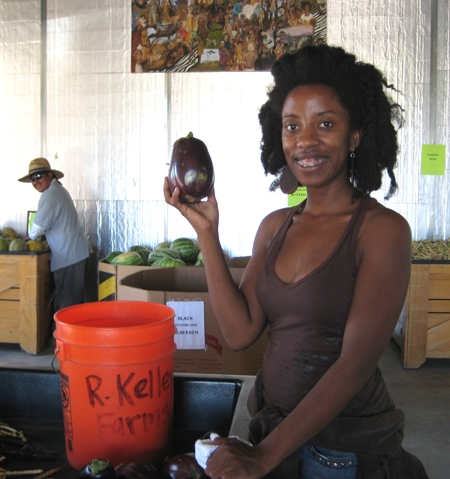
Lynette Hall's stuffed zucchini: Cut a big zucchini squash in half. Scrape out the seeds. Saute onions, garlic and bell peppers with some sausage and hamburger meat. Add some uncooked saffron yellow rice and a couple of eggs to bind everything together. Fill the hollowed-out squash halves with the mixture. Top with a layer of mozzarella cheese and some bread crumbs. Bake at 375 to 400 degrees for about 45 minutes.
Lynette Hall's succotash: Start with meat in a frying pan. When the meat is tender, add the vegetables, using any combination of onions, garlic, okra, peppers, squash, eggplant, tomatoes, fresh beans and corn. Cut the corn fresh off the cob, cutting the kernels half-way through. Then scrape the corn milk off the cob to get the juice. The corn juice adds to the tomato juice to flavor this dish. Season to taste. Serve over rice.
More black eye pea information and recipes.
When I paid for my beans at R. Kelley Farm, I picked up a flier on the counter telling me about fresh pears at Maggi's Farm, just next door. So of course I had to stop by Maggi's for some pears on my way home. But that's another story.
A fruitful approach
I have two active young sons. They get plenty of exercise. Their diets, however, can be a challenge. They have different tastes – one could eat breakfast items all day; the other could eat dinner items all day. One likes sugary sweet foods; the other likes salty, fatty foods. My wife is a great cook who makes balanced, nutritious meals, but it’s not easy pleasing everybody. There is one thing we all can agree on: We love fruit.
We can eat fruit throughout the day. It might go with breakfast, with lunch, as a snack or mixed in with a salad at dinner. I think my kids like fruit not only because we make it available and encourage them to eat it, but because they have sampled fresh fruit at farmers markets, watched it grow in our backyard and harvested it themselves at U-pick farms.
The federal government’s new MyPlate nutrition guidelines emphasize fruits and vegetables – they’re half the plate. But it’s not enough to try to force-feed your children canned carrots. Food can be fun. Giving kids a hands-on experience with fresh fruit can help them appreciate its importance. I’m no dietitian, but as a parent, I offer three tips for helping children to eat more fruits (and vegetables).
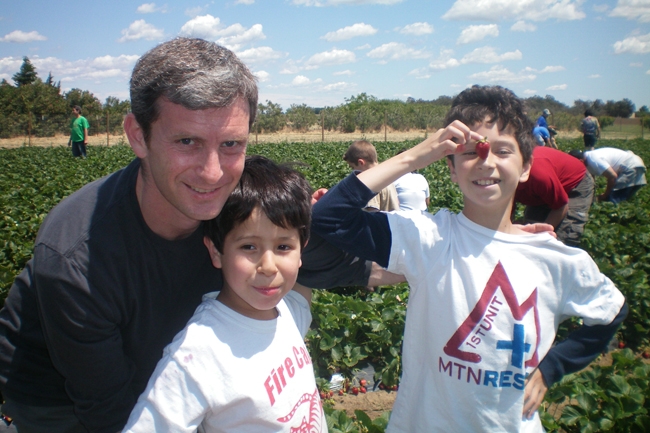
- Go to a farmers market. California has more farmers markets than any other state in the country. Find one near you at www.cafarmersmarkets.com. At a farmers market, the food and the farmers are the stars. You can sample the goods. You can ask a farmer questions. You can learn about the difference between a blood orange and a Cara Cara orange. It’s an event, but a short one. And the price is moderate.
- Grow your own produce. We’ve had mixed results with this one. Tomatoes came out great one year, were poached by animals another. We have a couple of fruit trees in our yard, but they don’t get much sun and the fruit isn’t sweet. We have had success with herbs, though, and find that our sons will munch on a mint leaf or point out the plants to friends and family. On a recent visit to their aunt and uncle’s house, they picked giant lemons and enjoyed homemade lemonade. No matter how small the effort, it shows children the life cycle of a plant, the anticipation of healthy food and, hopefully, the payoff of plentiful produce for a low cost.
- Visit a U-pick farm. We get an early start to summer by visiting U-pick farms in Brentwood. One son prefers cherries; the other prefers strawberries. Between the two, we have a daylong excursion that provides a weeklong supply of delicious bite-sized fruit for a reasonable price. Brentwood’s cherry season typically lasts from May to June. You can still find peaches, strawberries and other crops there in July. We also went apple picking in September in Sonoma County. U-picking is part of the broader field of agritourism, which also can include farm stands, tours, fairs and festivals. The University of California maintains a statewide agricultural tourism directory at http://calagtour.org. Check it out and may your efforts be fruitful.
U-pick organic strawberry season opens on coast
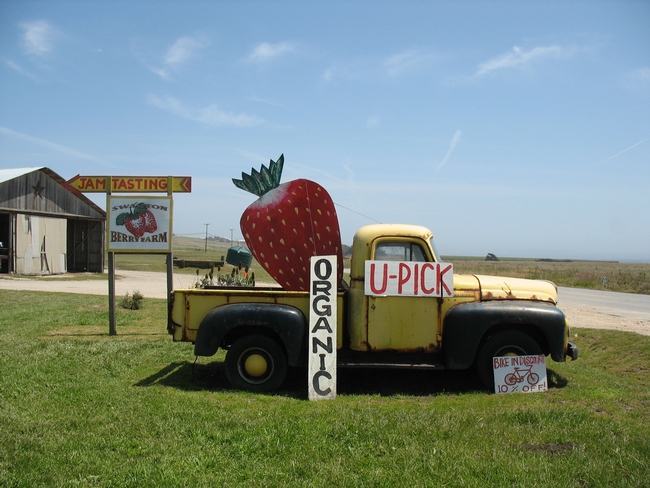
The U-pick strawberry fields at Swanton Berry Farm near Davenport on the coast are formally opening on May 28, but if you drive out there now, you’ll get a chance to pick without a crowd. Talking to Barrett Boaen, the U-pick manager, I got to the bottom of just why their berries, also sold at local Whole Foods stores, look and taste so good.
Partly it’s the ‘Chandler’ variety, chosen for its old-fashioned sweetness and flavor although it yields only about two-thirds as well as some varieties. It’s also about not pumping up production with too much nitrogen or irrigation (more details here). Mostly, though, it’s about the picking process. A strawberry grower visiting from the East Coast recently bought two flats from the farmstand, saying he couldn’t help himself, he had never laid eyes on such beautiful organic berries, and he knew who to congratulate—the pickers.
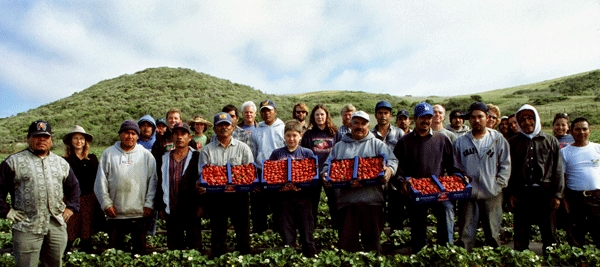
You and I are unlikely to come close to picking as well as Swanton’s unionized employees, some of whom have more than 20 years of experience at the farm. They recognize when a strawberry is as ripe as it can be, when it’s red and sweet all the way through (strawberries don’t continue ripening once they are picked). Although a less ripe berry is firmer, with a longer shelf-life and easier to transport, it has less flavor, so the pickers wait a day or two for any berry with a green tip or white shoulders to ripen perfectly. They discard berries that are soft on one side (from raindrops settling on the fruit) or have a cat-face look, which is lygus bug damage.
Moving along the rows, which are banked up to 18 inches high to reduce back strain, they harvest each perfectly ripe berry, with its green calyx attached, in a “twist and flick” motion: “you put tension on the stem above the calyx, and rotate it, so you can see 360 degrees and whether there’s any damage to the berry; then with just the right tension, the berry will pop off naturally,” explains Boaen.
In the U-pick fields, which have ocean views, visitors pick for pleasure, hopping from row to row, enjoying the fresh air, and the fragrance of the berries and the earth. Compared to the serious work in the other 20 acres of strawberries, “the 3 acres of U-pick are a playground,” says Boaen, “We provide people everything they need to be happy.”
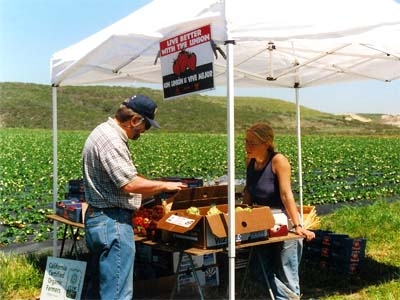
“It can be demoralizing,” Boaen admits. “All that energy put into the fruit after the excellent warm January was wrecked.”
Fortunately, the farm has several other crops, and the strawberry fields are filling with new berries. You can pick them this summer for $2.50 per pound (10 percent discount for bicyclists). Bring your own containers if you remember, a windproof jacket and boots in case of fog or mud, and most of all, Boaen recommends allowing plenty of time to enjoy yourself.
By mid-June, Swanton ollalieberries will be ripe, and by mid- or late July, the blackberries will be ready. Farm tours are available by reservation. Organic strawberry and ollalieberry jams, and five other kinds, are available at the farmstand or online.
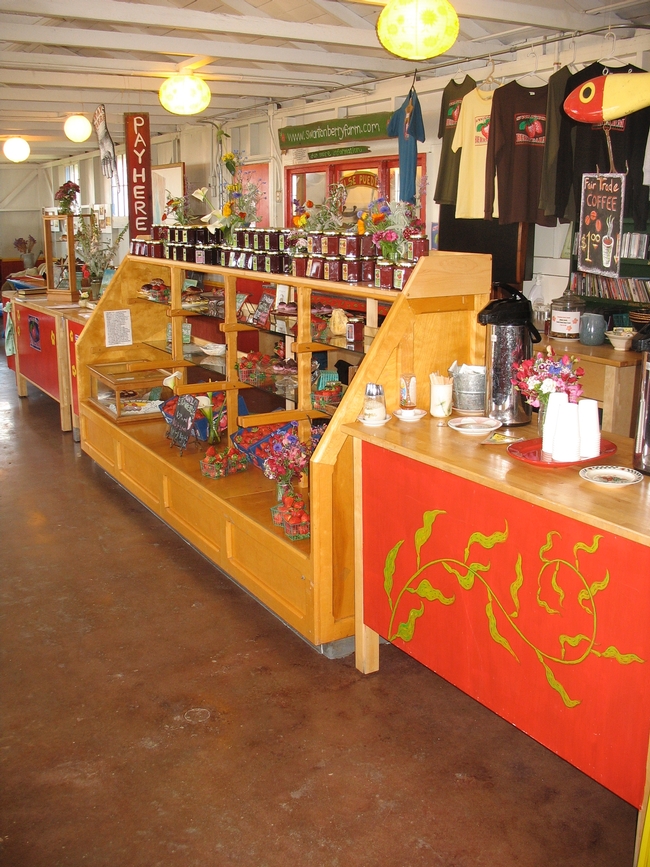
Swanton's farmstand